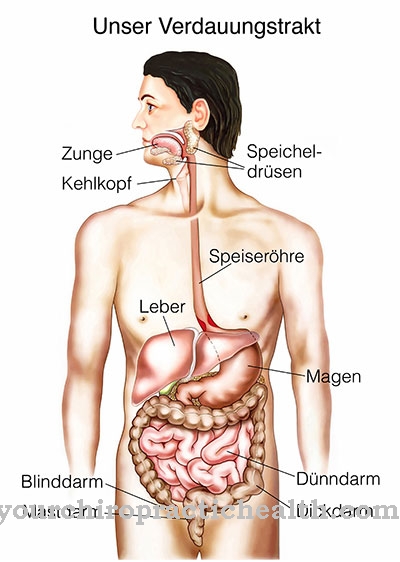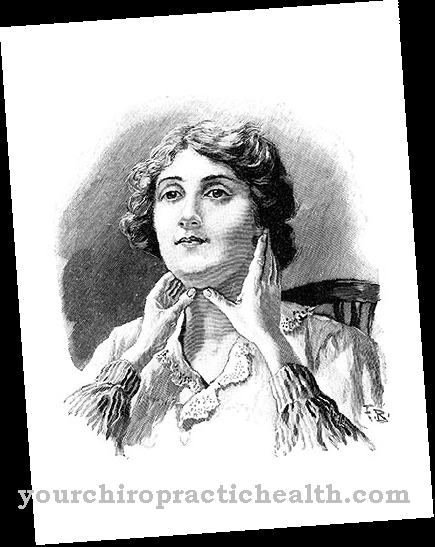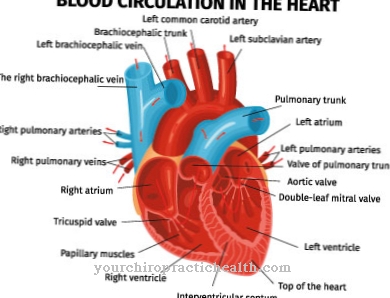Platelets - also known as platelets - play an important role in the human body. They regulate blood clotting and ensure that wounds do not bleed continuously and thus no blood loss occurs. There are different diseases that affect the properties or the number of platelets. These are called Thrombocytopathy summarized.
What is thrombocytopathy?

© L.Darin - stock.adobe.com
Under Thrombocytopathy Scientists understand all the clinical pictures that cause platelet dysfunction. This means that the thrombocytes cannot carry out their normal function - helping blood to clot - as usual. This means that bleeding is no longer stopped as quickly, but rather lasts longer. Bleeding also occurs frequently.
The number of platelets remains unchanged. There are two forms of thrombocytopathy: inherited and acquired. Most of the thrombocytopathies diagnosed are of the acquired form.
Hereditary thrombocytopathies can be traced back to various syndromes. The Bernard-Soulier syndrome and Willebrand-Jürgens syndrome are known, among others. Another rare disease is Glanzmann's thrombastenia. All clinical pictures have in common that they result in a genetic defect that prevents the platelets from performing their natural function.
causes
Acquired thrombocytopathy has many causes. They occur, for example, when the immune system is weakened by an infection. If the kidneys are impaired, for example in the case of renal insufficiency, the dysfunction of the blood platelets can be a concomitant disease. Liver diseases can also lead to such a clinical picture. In addition, patients with leukemia sometimes have thrombocytopathy.
The dysfunction occurs very often in connection with the use of medication. Above all, pain relievers (e.g. aspirin) and anti-inflammatory drugs such as diclofenac should be mentioned here. Certain antibiotics, such as penicillin, have also been identified as the cause. The influence of drugs is significant. Doctors must take this into account in upcoming operations.
This is because poorly functioning blood clotting can have fatal consequences. Therefore, such substances should be discontinued for a sufficient period of time before the planned procedure.
Symptoms, ailments & signs
The clinical picture of thrombocytopathy shows various symptoms. Very often, patients suffer from increased nosebleeds. Bleeding gums are also a typical feature. Internal bleeding, such as from the gastrointestinal tract, which shows up as blood in the stool, may also be an indication. People who discover an above-average number of bruises (bruises) on their body should also consult a doctor.
In women, thrombocytopathy manifests itself as an unusually long menstrual period. After minor surgery or the extraction of a tooth, prolonged bleeding can be a sign of the coagulation disorder.
Diagnosis & course of disease
If one or more of the symptoms described above occurs, a doctor should be consulted. There are various aspects to consider when making a diagnosis. First there is a general questioning of the patient. Here the doctor is interested in bleeding events that have occurred and corresponding occurrences in relatives. After taking this anamnesis, the doctor asks questions about possible drug consumption, as this, as already described, is the main cause of thrombocytopathy.
If the suspicion of a disease is confirmed, the doctor determines the clotting time using a so-called search test. Here, after a slight incision, he determines the time until coagulation. A final laboratory examination provides the final confirmation for a reliable diagnosis.
Complications
With thrombocytopathy, those affected suffer from a number of different complaints. First and foremost, nosebleeds are very common in this disease. This complaint can have a very negative effect on everyday life and the quality of life of the person affected and significantly limit this. Bleeding from the gums also occurs frequently and can lead to infections in the gums.
Patients also suffer from stomach or intestinal problems, which can lead to bloody stools. There is a high number of bruises or bleeding on the skin due to thrombocytopathy. In women, the disease can also lead to prolonged menstrual periods. Even light wounds or cuts bleed longer and the patient's wound healing is significantly delayed.
Thrombocytopathy can usually be treated relatively easily with the help of medication. There are no particular complications. However, this treatment must be carried out throughout life. Even with surgical interventions, the risk of bleeding must be better assessed. As a rule, this condition does not reduce the patient's life expectancy.
When should you go to the doctor?
If human bleeding cannot be stopped or is very difficult to stop, a doctor should be consulted immediately. If large amounts of blood are lost even with small wounds, this is considered unusual and a sign of a health problem. A doctor is needed because a life-threatening condition threatens with an unfavorable course of the disease. If bleeding cannot be stopped, there is a risk of bleeding to death from cuts.
Frequent nosebleeds or bleeding gums are indications of an illness. Consult a doctor if bruises or hematomas form even when the skin is exerted lightly. Discoloration of the skin, unusual paleness and poor resilience should be presented to a doctor. If sexually mature girls or women have very heavy menstrual periods with enormous blood loss, a doctor must be consulted. If bleeding leads to dizziness, malaise, internal weakness or loss of physical strength, we recommend clarifying the cause.
General dysfunctions, blood loss when using the toilet, and fatigue and exhaustion are other complaints that need to be investigated. In the case of headaches, irregularities in memory, sleep disorders and palpitations, it is advisable to clarify the cause. Medical examinations are required so that a diagnosis can be made and a treatment plan can be established.
Therapy & Treatment
In order to treat thrombocytopathy, the primary cause is to be identified. If the illness is caused by the intake of medication, they are discontinued if possible. In order to continue treating the causative disease, the doctor will prescribe an alternative medicine. If action is to be taken actively against the coagulation disorder, the administration of so-called DDAVP (1-desamino-8-D-arginine-vasopressin) substances is recommended.
These help restore the natural function of the platelets. A nasal spray or an infusion are common forms of administration. The doctor uses test applications to determine whether the treatment with the substance was successful. In an emergency, affected patients receive a transfusion. This may be necessary during an operation if an existing thrombocytopathy was not previously diagnosed.
In this process, platelets are brought into the sick person's bloodstream from a healthy donor. A risk here is that the recipient cannot tolerate the transfusion and the administered blood platelets will be rejected.
prevention
If a blood coagulation disorder is sufficiently known before an upcoming procedure, preventive measures must be taken. In addition to discontinuing the drugs causing the disease, the attending physician can also administer the hormone desmopressin. This causes the platelets to adhere better to the injured area and thus accelerate the coagulation process again. Depending on the type of procedure, the doctor has the choice between administration as a nasal spray (for example in the case of a tooth extraction) or via the vein (during operations).
Children and adolescents with the congenital variant of thrombocytopathy also receive numerous preventive measures to prevent the condition from worsening. This includes the regular administration of platelet concentrates, which take over the function of the impaired blood platelets. In addition, affected children are given special drugs that lead to an increased formation of coagulation factors.
Girls with the disease take supportive hormones during their menstrual period. Since liver disease is a cause of the clotting disorder, vaccination against hepatitis A and hepatitis B is advisable.
Aftercare
In most cases, the options for direct follow-up care for thrombocytopathy are significantly limited or, in some cases, are not even available to the person concerned. Therefore, they should consult a doctor at the first signs and symptoms of this disease and initiate treatment so that there are no complications or other complaints in the further course.
The earlier the thrombocytopathy is recognized and treated by a doctor, the better the further course of this disease is usually. Most of those affected are dependent on taking various medications. This limits the symptoms and also significantly alleviates them.
It is important to ensure the correct dosage and regular intake. If you have any questions or if you have any side effects, you should always consult a doctor first. Furthermore, regular checks and examinations should be carried out by a doctor. Those affected with thrombocytopathy are often dependent on lifelong therapy to counteract the symptoms. However, the life expectancy of the person affected is not restricted by the disease. In some cases, contact with other people affected by the disease makes sense, as this can lead to an exchange of information.
You can do that yourself
Thrombocytopathy is only treated if you have physical symptoms. The dysfunction of the platelets usually does not result in any health problems. The self-help measures are limited to paying attention to unusual symptoms after the diagnosis, which may indicate illness.
The doctor must be informed of these symptoms. If there are no health problems, a general practitioner or an internist should be consulted regularly. A regular measurement of the blood values is indicated in order to check the dysfunction of the platelets and at the same time to determine any physical symptoms. If health problems are found, drug treatment, such as desmopressin, is usually given. The patient can support the treatment by taking care of himself and following a healthy lifestyle. It is also important to pay attention to any side effects and interactions of the drug treatment. The doctor must be informed about side effects so that the necessary measures, usually changing the drug administration, can be initiated quickly.
Further self-help measures are usually not necessary in the case of thrombocytopathy. The dysfunction of the platelets should therefore mainly be treated preventively by discontinuing triggering drugs such as diclofenac or penicillin.





.jpg)






.jpg)



.jpg)










.jpg)
